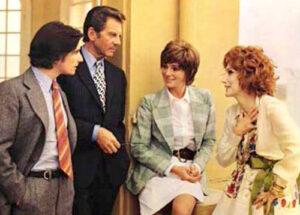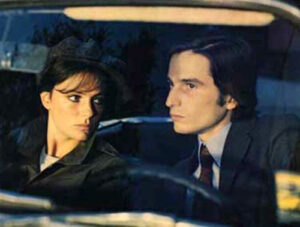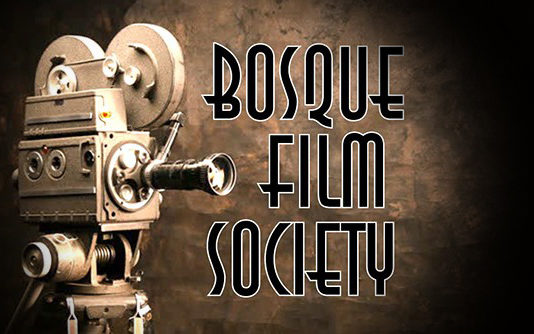With its bi-monthly members-only Arthouse Film Night Series, the Bosque Film Society presents Francois Truffaut’s 1973 French New Wave classic “DAY FOR NIGHT” Tuesday, Nov. 15 at The Cliftex Theatre in Clifton
By BRETT VOSS
Bosque Film Society Founding Board President
For its last ARTHOUSE FILM NIGHT of 2022, I had the honor of introducing the Bosque film Society’s members-only presentation of Francois Truffaut’s 1973 French New Wave classic “DAY FOR NIGHT” Nov. 15 at The Cliftex Theatre in Clifton. The film premiered at the 1973 Cannes Film Festival and won the Academy Award for Best Foreign Language Film the following year.
Starring, directed and written by Truffaut, “DAY FOR NIGHT” chronicles the production of Je Vous Présente Paméla, a clichéd melodrama starring aging screen icon (Jean-Pierre Aumont), former diva (Valentina Cortese), young heartthrob Alphonse (Jean-Pierre Leaud) and British actress Julie Baker (Jacqueline Bisset), who is recovering from both a nervous breakdown and the controversy over her marriage to her much older doctor.
 To be honest, I was genuinely surprised when this film was selected in the voting by our members last October. With that said, to the American movie-going public, it’s probably the most obscure film among our selections. And in many ways, this film stands apart from all of the films we have screened so far, not only for its style of filmmaking, but also for what it represents. For me, Day For Night represents everything I love about film, not for the movie itself, but for its artistic and unique approach to storytelling and filmmaking.
To be honest, I was genuinely surprised when this film was selected in the voting by our members last October. With that said, to the American movie-going public, it’s probably the most obscure film among our selections. And in many ways, this film stands apart from all of the films we have screened so far, not only for its style of filmmaking, but also for what it represents. For me, Day For Night represents everything I love about film, not for the movie itself, but for its artistic and unique approach to storytelling and filmmaking.
Discussion of this film must begin with the French New Wave movement because without it, the film would have never happened. The New Wave (Nouvelle Vague) film movement rose in popularity in the 1950s in Paris aimed at giving directors full creative control over their work, allowing them to reject the strong, easy-to-follow narratives favored by the studios in favor of improvisational, existential storytelling. Imagine, if you will, an expressionist painting becoming the art of film, presenting the world solely from a subjective perspective, distorting it radically for emotional effect in order to evoke moods or ideas.
Edvard Munch, our inspiration behind “Gal Manns Skirk” was one such expressionist artist. A group of film critics and cinephiles – Jean-Luc Godard and Francois Truffaut among them – pushed against big film studios controlling the creative process, fighting for full control of their films. The movement gave birth to the “auteur theory,” the concept of filmmaking allowing for the artistic identity of the writer/director to become an expression of each film they made. They were inspired by the ground breaking work of Orson Welles and Alfred Hitchcock, which they greatly respected, especially for the creative freedoms the studios granted them at the time.
Now keep in mind, old Hollywood studio films aimed to entertain and pack the theater. They were not afraid to spend a lot of money if they felt sure to make even more.
 On the flip side, when I think of the French New Wave film movement, my favorite Tom Waits quote comes to mind. When being inducted into the Rock-n-Roll Hall of Fame in 2011, the genre-defying musician said “When my name came up to be inducted, they said ‘But he doesn’t have any hits’…and they said it like it was a BAD thing.”
On the flip side, when I think of the French New Wave film movement, my favorite Tom Waits quote comes to mind. When being inducted into the Rock-n-Roll Hall of Fame in 2011, the genre-defying musician said “When my name came up to be inducted, they said ‘But he doesn’t have any hits’…and they said it like it was a BAD thing.”
French New Wave films wanted to challenge audiences and keep them from becoming complacent while watching. They used innovative techniques, such as time-fractured narratives, jump cuts and actors addressing the audience directly. Due to budget constraints, directors often shot on location (rather than on elaborate sets) with handheld cameras using natural lighting and recording sound during takes (rather than studio dubbing).
Early American films considered a product of the French New Wave movement were Bonnie and Clyde (1967), Cool Hand Luke (1967) and The Graduate (1968).
Almost 60 years later, there’s nothing new about anything related to the French New Wave movement. Much of it has become the norm – which only serves to emphasize the impact and importance of this movement on filmmaking. Without it, we would not know directors like Martin Scorcese, Francis Ford Coppola, Robert Altman, David Lynch, Steven Soderbergh, PT Anderson, Christopher Nolan, David Fincher and Quintin Tarantino as the unique and profound filmmakers they have become. In my mind, Tarantino’s “Pulp Fiction” represents a modern masterpiece inspired by the French New Wave movement.
Auteurs of the New Wave movement were notable for their technical expertise in the craft of filmmaking, for their clearly distinguishing personality and style, and delivering layers of meaning and commentary about the human condition.
For me, the French New Wave movement delivered my favorite form of filmmaking and directing voices, many obscure and a few not so much…directors like Akira Kurosawa, Stanley Kubrick, Terrance Malick as well as my favorite and definitely the most challenging, Nicolas Roeg…the ultimate expressionist, time-fracturing filmmaker.
 With all of that said, we finally return to Francois Truffaut and “Day For Night.” After making a number of celebrated French New Wave films in the early 1960s, including The 400 Blows (1959), widely considered the best of all French New Wave films, Jules and Jim (1962), and Shoot The Piano Player (1960), Truffaut’s career drifted for a while, and Day For Night (1973) represented a bit of a comeback for him.
With all of that said, we finally return to Francois Truffaut and “Day For Night.” After making a number of celebrated French New Wave films in the early 1960s, including The 400 Blows (1959), widely considered the best of all French New Wave films, Jules and Jim (1962), and Shoot The Piano Player (1960), Truffaut’s career drifted for a while, and Day For Night (1973) represented a bit of a comeback for him.
Interestingly, it’s a film about making a film…the first mockumentary, if you will. One of the film’s themes within the layers of the narrative explores whether cinema is more important than life to those who make it. It makes many allusions both to filmmaking and to movies themselves, perhaps unsurprisingly since Truffaut began his career as a film critic who championed cinema as an art form.
I find it interesting to note that the original French title, La Nuit américaine (“American Night”), refers to the French name for the filmmaking process where sequences filmed outdoors in daylight are shot with a filter over the camera lens or also using film stock balanced for tungsten light and underexposed – or adjusted during post-production – to appear as if they are taking place at night. In English, the technique is called “day for night.”
And on a personal note, the film opens with a picture of Lillian and Dorothy Gish, dedicating the film to the Gish sisters, whom Truffaut called “the first two actresses of the cinema.” As some of you know, Lillian and Dorothy were my maternal grandfather’s first cousins. On my mother’s side of the family, the Gish sisters set the standard for all of the women in our family, and my five Gish girls – my mother and my four aunts, all gone now – exemplified them in so many ways. My sister Terri and our only girl cousin Brenda have carried on the family tradition of beautiful blonds, and my wife Simone was recently inducted as an honorary Gish girl.
In conclusion, Francois Truffaut said the film was made in “the spirit of friendship for all the people in the movie business.” And in everything we do, what a wonderful world that would be.
